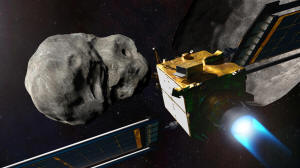NASA's asteroid-deflecting DART spacecraft nears planned impact with its
target
 Send a link to a friend
Send a link to a friend
 [September 26, 2022]
By Steve Gorman [September 26, 2022]
By Steve Gorman
(Reuters) - Ten months after launch, NASA's
asteroid-deflecting DART spacecraft neared a planned impact with its
target on Monday in a test of the world's first planetary defense
system, designed to prevent a doomsday collision with Earth.
The cube-shaped "impactor" vehicle, roughly the size of a vending
machine with two rectangular solar arrays, was on course to fly into the
asteroid Dimorphos, about as large as a football stadium, and
self-destruct around 7 p.m. EDT (2300 GMT) some 6.8 million miles (11
million km) from Earth.
The mission's finale will test the ability of a spacecraft to alter an
asteroid's trajectory with sheer kinetic force, plowing into the object
at high speed to nudge it astray just enough to keep our planet out of
harm's way.
It marks the world's first attempt to change the motion of an asteroid,
or any celestial body.
DART, launched by a SpaceX rocket in November 2021, has made most of its
voyage under the guidance of NASA's flight directors, with control to be
handed over to an autonomous on-board navigation system in the final
hours of the journey.
Monday evening's planned impact is to be monitored in real time from the
mission operations center at the Johns Hopkins University Applied
Physics Laboratory (APL) in Laurel, Maryland.

DART's celestial target is an asteroid "moonlet" about 560 feet (170
meters) in diameter that orbits a parent asteroid five times larger
called Didymos as part of a binary pair with the same name, the Greek
word for twin.
Neither object presents any actual threat to Earth, and NASA scientists
said their DART test cannot create a new existential hazard by mistake.
Dimorphos and Didymos are both tiny compared with the cataclysmic
Chicxulub asteroid that struck Earth some 66 million years ago, wiping
out about three-quarters of the world's plant and animal species
including the dinosaurs.
Smaller asteroids are far more common and pose a greater theoretical
concern in the near term, making the Didymos pair suitable test subjects
for their size, according to NASA scientists and planetary defense
experts.
Also, their relative proximity to Earth and dual-asteroid configuration
make them ideal for the first proof-of-concept mission of DART, short
for Double Asteroid Redirection Test.
ROBOTIC SUICIDE MISSION
The mission represents a rare instance in which a NASA spacecraft must
ultimately crash to succeed.
[to top of second column]
|

NASA's Double Asteroid Redirection Test
(DART) spacecraft prior to impact at the Didymos binary asteroid
system showed in this undated illustration handout. NASA/Johns
Hopkins/Handout via REUTERS

The plan is for DART to fly directly into Dimorphos at 15,000 miles
per hour (24,000 kph), bumping it hard enough to shift its orbital
track closer to its larger companion asteroid.
Cameras on the impactor and on a briefcase-sized mini-spacecraft
released from DART days in advance are designed to record the
collision and send images back to Earth.
DART's own camera is expected to return pictures at the rate of one
image per second during its final approach, with those images
streaming live on NASA TV starting an hour before impact, according
to APL.
The DART team said it expects to shorten the orbital track of
Dimorphos by 10 minutes but would consider at least 73 seconds a
success, proving the exercise as a viable technique to deflect an
asteroid on a collision course with Earth - if one were ever
discovered. A small nudge to an asteroid millions of miles away
could be sufficient to safely reroute it away from the planet.
The test's outcome will not be known until a new round of
ground-based telescope observations of the two asteroids in October.
Earlier calculations of the starting location and orbital period of
Dimorphos were confirmed during a six-day observation period in
July.
DART is the latest of several NASA missions in recent years to
explore and interact with asteroids, primordial rocky remnants from
the solar system's formation more than 4.5 billion years ago.
Last year, NASA launched a probe on a voyage to the Trojan asteroid
clusters orbiting near Jupiter, while the grab-and-go spacecraft
OSIRIS-REx is on its way back to Earth with a sample collected in
October 2020 from the asteroid Bennu.
The Dimorphos moonlet is one of the smallest astronomical objects to
receive a permanent name and is one of 27,500 known near-Earth
asteroids of all sizes tracked by NASA. Although none are known to
pose a foreseeable hazard to humankind, NASA estimates that many
more asteroids remain undetected in the near-Earth vicinity.

NASA has put the entire cost of the DART project at $330 million,
well below that of many of the space agency's most ambitious science
missions.
(Reporting by Steve Gorman in Los Angeles; Editing by Will Dunham)
[© 2022 Thomson Reuters. All rights
reserved.]
This material may not be published,
broadcast, rewritten or redistributed.
Thompson Reuters is solely responsible for this content. |